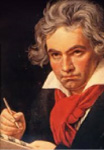|
|
Ludwig van BeethovenNationality: German Born – Bonn, Germany, December 17, 1770 Died – Vienna, Austria, March 26, 1827 Period: Classical |
|
| This year’s Music Memory program includes the 3rd movement, or “Rondo, allegro,” from Beethoven’s Piano Concerto No. 5. It’s one of his best known and most frequently played compositions, and is often called the Emperor Concerto. It was the last piano concerto that Beethoven composed. Beethoven wrote the concerto between 1809 and 1811 while he was living in Vienna. He dedicated the concerto to Archduke Rudolf, his patron and pupil.
In rondo form, a principal theme (sometimes called the “refrain”) alternates with one or more contrasting themes, generally called “episodes.” Before listening to the Emperor Concerto, let’s listen to a rondo written by Mozart. It’s called “The Turkish March,” played here by the Italian pianist, Massimiliano Ferrati. As you listen, follow the listening map and see if you can spot when the theme changes. On the listening map, each theme is represented by a different image. The themes are labeled “A,” “B,” and “C” and the overall pattern of the movement is ABCBAB. Listen closely and see if you can hear when theme “B” is being repeated during the rondo. |
||
|
Theme A |
Theme B (Main) |
Theme C |
|
Theme B (Main) |
Theme A |
Theme B (Main) Ants at Work  |
|
Coda (Italian for “tail”)
|
||
| MUSIC MEMORY SELECTION:Now we’re ready to listen to the “Rondo, Allegro” from Beethoven’s Emperor Piano Concerto. Here is the New York Philharmonic conducted by Kurt Massur, with pianist Alfred Brendel playing the 3rd movement from the Emperor Concerto. The overall pattern of this rondo is ABACABA.
KEYWORDS: rondo / concerto / patron / coda / allegro / archduke THINGS TO THINK ABOUT:
|
||






